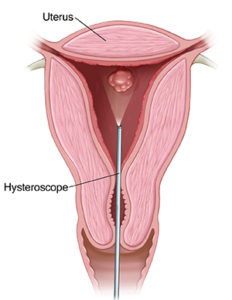HYSTEROSCOPY

» Hysteroscopy is a technique to look inside the womb (uterus). It is done with a narrow tube-like telescope with a camera called hysteroscope. A hysteroscopy can be used to diagnose and/or treat a problem with the womb.
» To check for polyps (abnormal growths that start in the inner lining of the colon) or some types of fibroids (non-cancerous growths of muscle in your womb). These may then be treated during your hysteroscopy.
» To check for polyps (small growths of tissue in your womb lining) or some types of fibroids (non-cancerous growths of muscle in your womb). These may then be treated during your hysteroscopy.
» To see if there are any problems within your womb if you’re having problems getting pregnant or have had several miscarriages.
» To treat scar tissue (adhesions) within the lining of your womb.
» To take out an intra-uterine system (IUS), or coil, that has moved out of place.
» To carry out a permanent form of contraception (sterilization).
A hysteroscope is practiced to improve an unusual condition, during an efficient hysteroscopy, that has been identified during a diagnostic hysteroscopy. If an abnormal condition is detected, an operative hysteroscopy is often performed at the same time, avoiding the need for a secondary operation. During operative hysteroscopy, little devices used to improve the condition are injected through the hysteroscope. In various circumstances, effective hysteroscopy may contribute an alternative to hysterectomy.
A gynecologist may perform a hysteroscopy to correct the following uterine conditions:
- Polyps and fibroids : Hysteroscopy is practiced to eliminate these small non-cancerous lumps found in the uterus.
- Abnormal bleeding : Hysteroscopy is practiced to eliminate these small non-cancerous lumps found in the uterus.
-
Endometrial ablation : One method in which the hysteroscope, accompanying with other devices, is used to finish
the uterine lining in position to explain some causes of heavy bleeding. -
Adhesions : Uterine adhesions are strips of scar tissue that can develop in the uterus and may manage to variations in
menstrual discharge as well as unproductiveness. Hysteroscopy can help gynecologist to find and eliminate the adhesions. -
Septum : Hysteroscopy can ease decide whether you have a uterine septum, a distortion of the uterus that is started
from the beginning. - Conditions that affect cerebra-spinal fluid flow such as hydrocephalus
Hysteroscopy is often done as an outpatient procedure, especially if it’s being done to look for problems in your womb. You won’t need to stay in the hospital overnight and you’ll be awake during your procedure. If you’re having treatment during your hysteroscopy, a gynecologist may recommend that you have the procedure under general anesthesia. This will probably be as a day case. This means you’ll be asleep during the operation, but you’ll go home later the same day. If you’re having a general anesthetic, you’ll be asked to follow fasting instructions. This means not eating or drinking, typically for about six hours beforehand. However, it’s important to follow your gynecologist’s advice.
As a specialty hospital, Aashirwad Hospital Raipur gives you the advantage of expert and quality healthcare with all the benefits of a large hospital but in a friendlier, more accessible facility.